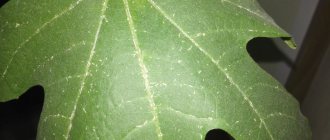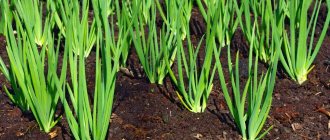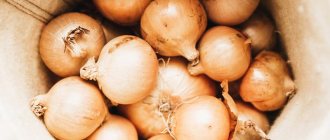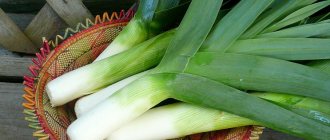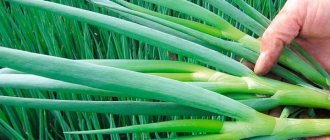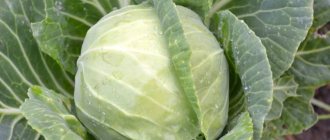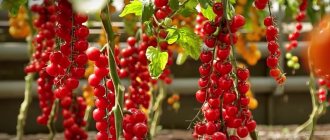To germinate or not?
Actinidia seeds cannot be germinated in the usual way; the seed must be stratified:
- Place in water for 4 days, replacing the liquid daily.
- Place in a stocking and bury in a container with damp sand.
- Leave in a room with a temperature of 19 ° C for 1 month, removing and rinsing with water weekly.
- Place the container with sand in the snow or refrigerator for 2 months.
- Return to a room with a temperature of 11 ° C.
- Wash the seeds weekly until they begin to hatch.
How to save seedlings and cuttings purchased in advance
During the mass planting season, prices for seedlings are very high. In addition, good planting material sells out quickly. For these reasons, gardeners often buy seedlings for spring planting in advance, when the snow has not yet melted in the garden. It’s easy to explain where seedlings come from in winter. These are plants that were not sold in the fall, or cuttings that took root in the fall. In winter they are stored in basements at low temperatures.
In winter, seedlings are stored in cold and dark rooms
If storage conditions are not met, with the onset of the first thaw, the seedlings wake up. Leaves and even twigs appear from the buds. The prices for such planting material are reasonable, since they need to be sold quickly. After all, from a lack of light, the leaves and twigs become more and more elongated and pale every day, and their presentation deteriorates.
This is what seedlings look like when they wake up and start growing in the basement
If you bought such a seedling, and even with an open root system, plant it in a pot or bucket and keep it on the windowsill, like an indoor flower. Any ready-made soil from the store will do, which contains loosening materials: peat, perlite, vermiculite, etc. Planting in open ground can only be done when the threat of frost has passed.
The bark and buds of kolomikta are resistant to sub-zero temperatures, but the leaves die at -4 ⁰C. In the spring, this is deadly for the plant, because its old buds have already blossomed, but new ones have not yet formed.
Video: what to do with seedlings that woke up ahead of time
Another option is that you bought woody cuttings or cut them in the garden in the fall, or they sent you dormant seedlings in the winter. Store them in a dark room at a temperature of 0... +5 ⁰C. Tie the cuttings into a bundle and stick them vertically into damp sand. Sprinkle the roots of the seedlings with wet sawdust.
Landing in the ground
In order to plant kiwi, you need to prepare the soil and suitable sized containers. At the beginning of March, each seed that has begun to open is buried 4-5 mm into moist soil. Further growth of actinidia depends on proper care of the seedlings. A crop grown from seeds begins to bear fruit late, 6-10 years after planting.
Required soil composition and container size
The container for planting actinidia should be spacious and deep enough. A suitable first container for the vine should have a capacity of more than 12 liters. To grow actinidia in a pot, you need high-quality soil rich in nutrients. Soil acidity varies between 5.5-7 pH. You can make the mixture yourself by mixing the following ingredients:
- 4 liters of soil from the garden;
- 4 liters of rotted pine needles or acidified peat;
- 2 liters of sand;
- 2 liters of herbal humus.
How long do seedlings germinate?
It takes a lot of time to germinate actinidia. The seeds begin to burst approximately 2-3 months after the start of stratification.
Placing containers in a warm place on a well-lit windowsill allows you to get vigorous shoots 15 days after planting in the ground.
Seedlings grown from seeds stretch 2.5 cm by the end of the first year. Next year, the sprouts will increase to 35 cm, and a year later - to 1 m. At this age, the plants are ready to be transplanted to a permanent location.
Popular varieties of actinidia
Exotic actinidia with juicy and sweet fruits is of interest to many owners of country plots and private houses. Beautifully flowering vines can be used in park and landscape design.
Actinidia Kolomikta
This shrub vine is cultivated to produce tasty berries and for garden decoration.
In the habitat
It grows naturally throughout the Far East. It is most common in spruce-fir forests with the presence of broad-leaved trees on the edges, clearings, along the banks of small rivers and springs. Not being a representative of layered vegetation, it forms undergrowth along with aralia, lemongrass, hazel and honeysuckle. Prefers humus, drained soil. It can grow along the edges of rocky areas.
Actinidia kolomikta
Woody vines kolomikta have a trunk from 2 to 5 cm in diameter with climbing branches reaching up to 15 m in height. Touching a thin support (up to 80 mm), the shoots wrap around it, climbing up in a spiral.
Interesting! During the growing season, the foliage radically changes color several times: if at the beginning of the season it is bronze in color, then green; during flowering, the tips turn white, then after the ovaries appear, they turn pink, later they turn carmine red. In autumn they become yellow, lemon, lilac-red, pinkish. Such variegation appears only in Actinidia kolomikta, growing in a lighted place.
It begins to bloom from the 5th year of life at the end of June for 15-18 days. The flowers are white, with a pink tint and a delicate aroma.
Edible fruits of actinidia
The fruits are green berries with dark stripes 3.5 cm long and 1.5 cm in diameter, aromatic and sweetish in taste, similar to strawberries, watermelon, and pineapple.
Kolomikta begins to bear fruit in the 9th year. The berries ripen in the first ten days of September. In good conditions it grows for up to 140 days. Life expectancy is up to 90 years.
This type of actinidia is the most winter-hardy and is suitable for cultivation in regions with cold climates.
Prices for Actinidia Kolomikta
Actinidia Kolomikta
Actinidia Arguta
The longest (up to 28 m) of the actinidia, the liana is distributed along the Far Eastern sea coast and in mixed forests.
Arguta fruits
The trunks are 13 cm in diameter with wide oval foliage (13 x 17 cm) of green color. The flower is white-green, 1.5-2 cm in size, fragrant. Flowering is short - just over a week.
The berries are round or oval 15-28 mm with thin skin, with a very sweet pulp of fig taste.
Actinidia Issai
The self-fertile subspecies of arguta is a pollinator of other varieties: Pineapple, Veiki, etc. The vines reach a height of 7-9 m and have good frost resistance (down to minus 30 degrees). It begins to bear fruit in the 3rd year of life.
Actinidia issai
The leaves are broadly elliptical in shape and dark green in color. The flowers are white, up to 6 cm in diameter. The green fruits are small (4 cm), sweetish, edible.
Prices for Actinidia Issai
Actinidia Issai
Actinidia Deliciosa
Shrub-type liana reaches 8-10 m in height. The leaves are oval (8 x 12 cm) bright green, the flowers are white-yellow, often bisexual, the fruits are kiwi. Habitat: China.
Dessert look
At the beginning of the 20th century it appeared in New Zealand, where from the 40s. cultivated on an industrial scale. Today, along with China, Italy is the leader in the supply of kiwi to the international market.
Rejection and replanting of sprouted plants
For normal pollination of dioecious actinidia and fruit production, it is necessary to plant vines of both sexes nearby. Excess seedlings are rejected based on gender after the first flowering. For 7-10 female plants, 1-2 male plants are needed, otherwise normal pollination and high yields cannot be obtained.
See also
Description and rules for using royal dates, benefits and harms
Read
Seedlings selected for transplantation are planted in separate planting holes at a distance of 1.5-2 m from each other. Sequence of procedure:
- Prepare holes with a diameter and depth of 0.6 m in 14 days.
- Place 10 cm of drainage at the bottom.
- Fill the holes halfway with a mixture of soil, humus, wood ash, and superphosphate.
- Place the actinidia in the hole and cover it with soil, leaving the root collar above the surface.
- Water the plants.
- Mulch the root circle.
How to prepare holes and plant actinidia
The planting pattern for kolomikta is 1x2 m, for arguta - 2x3 m. Gardeners who grow actinidia recommend planting male plants separately from females, and not between them, for example, at the beginning or end of a row, retreating about 5 m. Otherwise, the vines will intertwine , it will be difficult for you to figure out which ones to take cuttings from for propagation. In addition, male and female bushes are shaped differently.
Planting stages:
- Dig a planting hole with a diameter of 60 cm and a depth of 40 cm.
- Fill the hole halfway with topsoil, add a bucket of humus or compost, a tablespoon each of superphosphate and potassium sulfate. To loosen heavy soil, use: peat, last year's sawdust, fallen leaves, coarse sand, fine expanded clay, hay dust, chopped twigs and pieces of bark.
- Mix well and make a mound from this soil mixture for planting actinidia with an open root system. If the seedling is in a container, then make a hole the size of the root.
- Plant the sea anemone on a mound, spreading its roots along the slopes. The root collar should be at soil level and cannot be buried.
- Fill the empty spaces of the hole with loose soil.
- Make a hole and water.
- Mulch and install a net around each seedling. Young actinidia, like valerian, attracts cats. These animals can chew seedlings at the roots.
In the first year after planting, actinidia will have to be protected from cats.
When planting in spring, if there is no organic matter (humus or compost), add 30 g of urea or ammonium nitrate to the soil mixture. In autumn, do not apply nitrogen mineral fertilizers.
Further care
After planting, actinidia must be properly cared for. The liana definitely needs to have a reliable support; young shoots need to be indicated in the direction of growth and tied up. In addition, the plant actively develops in suitable environmental conditions.
Temperature and humidity
Actinidia is a deciduous crop, so if the growing temperature differs depending on the season, the crop sheds its leaves and enters the dormant stage. The same effect occurs due to insufficient humidity.
In winter, 7-10 °C is enough for the plant; in warm rooms and greenhouses the foliage on the vines is preserved.
Normal plant growth continues at 20 °C. At rest, some species of actinidia can tolerate frosts down to -45 °C.
Place lighting and ventilation
Areas well lit by the sun or in the shade are suitable for growing actinidia. It is ideal to combine bright light in the morning and partial shade in the afternoon. The place must be protected from strong winds and drafts.
Watering and fertilizing
Actinidia prefers moist soil, so you need to water the plant as the soil dries out. During the dry period, watering is carried out every 4 days at the rate of 80 liters of water per plant.
It is enough to apply fertilizers to the soil when watering several times a season:
- In early spring, nitrogen fertilizing is sufficient;
- at the beginning of fruit formation, you can add potassium-phosphorus mixtures with a small amount of nitrogen;
- After harvest there is enough potassium and phosphorus.
Bush formation
The formation of the actinidia crown begins after 3 years of growing the vine. The plant needs to be pruned according to the following scheme:
- At the very beginning of spring, it is necessary to thin out the shoots to avoid thickening of the crown.
- In summer, twigs can be pinched to reduce the growth rate of the vine.
- In autumn, plants older than 10 years are rejuvenated. Shoots are shortened to 25 cm.
- Winter is the time for sanitary pruning. It is necessary to remove intersecting branches that are thickened and growing downwards.
Transfer
It is necessary to transplant an adult plant to a new place in the spring or autumn, so as not to carry out the procedure while the sap is moving. You need to install supports for actinidia in advance and prepare planting holes. You need to dig the vine out of the ground carefully so as not to damage the surface root system.
Diseases and pests
Dangerous diseases of actinidia are:
- spotting;
- fruit rot;
- powdery mildew.
Prevention and treatment of fungal infections involves spraying with a solution of Bordeaux mixture, soda or chemical fungicides.
Growing in open ground makes actinidia an object of interest for insect pests:
- bark beetle;
- moths;
- lacewings;
- leaf beetle
The plant can be protected by spraying in spring and autumn with chemical insecticides or copper-based preparations.
Soil and place for actinidia
But it’s not enough to find planting material; you need to be sure that the soil on your site is suitable for growing this exotic plant. Actinidia grow well on chernozem, sandy loam, taiga, forest and other lands that have a loose structure that allows air to pass to the roots and does not retain water near them. On heavy, clayey soil, vines, even if they do not die, will not develop or bloom. If you really want to grow actinidia, even on clay soil, you will have to dig a large hole, the dimensions of which correspond to the size of the roots of an adult actinidia. Then fill it with loose and fertile soil.
Actinidia form a powerful root system with age, but most of it is located near the surface
The root of the kolomikta is a taproot, 120 cm deep. Many thin adventitious roots grow on it, forming a fibrous system. Most of it is located near the surface, at a depth of 0–40 cm, spreads within a radius of 60–80 cm from the trunk, and occupies an area of 1.1–2.0 m². Arguta is a more powerful plant, the length of the central root is about 4 m, the bulk of the feeding roots are located at a depth of 1–2 m, a space of 2–5 m² is required for one liana.
Acidity is important for actinidia; for good development, a slightly acidic environment is needed; the soil cannot be limed.
Knowing what plot of land your actinidia will occupy in the future, and considering that you need to plant at least 2-3 seedlings (male and female), you can begin choosing a location. The conditions on it should be close to natural. Plants live in taiga and deciduous forests, wrap their stems around tree trunks, which means they love moisture and sunlight scattered through the foliage.
Wild actinidia grow in the forest; they do not like direct sunlight
However, do not rush to place seedlings next to garden trees, since cultivated apple and pear trees are not as powerful as taiga cedars. Actinidia is an aggressively growing vine; it quickly takes over the surrounding area, entwining everything around with thick and woody shoots. As a result, an adult actinidia can win the competition for food and a place in the sun of all its neighbors.
Video: kolomikta planted on the eastern side of the building (Novosibirsk)
The culture likes to grow in the shade, but the fruits set and ripen in the sun. In a shady place, the stems stretch towards the light, and the fruits are set only at the tops. Experts advise placing vines so that they are well lit by the morning sun and protected from scorching rays during the day.
Actinidia needs strong supports; it is better to place them on the eastern side of the house
A site on the eastern side of a fence or building is quite suitable. But here you need to take into account the height of the vines. Thus, the length of the arguta whip reaches 7–15 m, and in the wild - up to 30 m, kolomikta is slightly lower. Having reached the height of the fence, they will begin to hang down and trail behind it. Planted near the house, they will climb onto the roof. It is inconvenient to care for such thickets. Therefore, actinidia need strong and high trellises. In the northern regions, even frost-resistant kolomikta will have to be laid on the ground along with trellises or removed from them. This means that next to the actinidia plantings there should still be enough space for them to shelter for the winter.
In autumn, in regions with frosty and snowy winters, vines are laid on the ground, and snow serves as a shelter
How to propagate a culture at home
There are several propagation methods for growing actinidia:
- cuttings;
- arc layers;
- root suckers;
- seeds.
Seedlings
To plant actinidia, you can use not only seeds; it is much easier to buy a ready-made varietal seedling. The main advantage of this propagation method is the rapid onset of fruiting. Seedlings grown from seed do not guarantee the preservation of varietal qualities, while seedlings retain all the properties of the species. Vegetative propagation simplifies the selection of plants by sex, so the sex of seedlings obtained from cuttings is known before flowering.
Cuttings
Actinidia is propagated by cuttings of two types:
- Green. In summer it is necessary to cut shoots 0.5-1 m, divide into parts with 3 leaves on each. Root the cuttings in a sand-humus mixture and cover with film, watering and spraying as necessary. In the spring, before the growing season begins, plants can be planted in a permanent place.
- Lignified. Cuttings should be prepared in the fall and stored vertically in sand at a temperature of about 3 ° C. In the spring, plant the branches in a greenhouse and care for them as if they were green ones.
When to plant actinidia
Planting dates depend on the growing region. So, in the south, spring is dry and warm, quickly giving way to hot summer, so it is better to plant here in the fall, in September - October. In the middle zone, in the north and in Siberia, autumn is not constant. Rainy weather sometimes lasts until November, but more often frosts begin to freeze the ground already in September. Therefore, it is better to plant young actinidia in the spring, in April - May. If you are lucky enough to buy seedlings with a closed root system, usually these are cuttings rooted in containers, then you can plant them even in summer.
Actinidia seedlings in containers can be replanted from spring to autumn
When planting in spring, plants should not be pinched or trimmed. Before the leaves bloom, damaged vines weep heavily and may dry out entirely. Do autumn planting about a month before the onset of frost on the soil. For seedlings with an open root system, it is desirable to have no leaves, that is, in the spring they have not yet blossomed, but in the fall they have already fallen off.
Video: summer planting of an actinidia seedling with a closed root system (Ukraine)
Will the plant bear fruit?
Actinidia will be abundantly covered with fruits only when female flowers are pollinated by pollen of the opposite sex. Therefore, it is important to distinguish a male plant from a female during the flowering period:
- Male inflorescences are formed from 3 buds, in the center of which there are a large number of stamens and no fruiting embryo.
- Female flowers are arranged separately on separate stalks. In the middle of the bud, an embryo with a radiant stigma is clearly visible; the stamens are present in small numbers and are significantly shorter in length.
Selection of actinidia planting material
Having decided to grow actinidia on your plot, find out whether it is possible to purchase planting material in your region. The culture is not widespread. In many cities, seedlings, especially varietal ones, cannot be found, or they are present in a small assortment. Meanwhile, about 30 varieties of actinidia of two types are included in the State Register: kolomikta and argut. They are all dioecious, there are male and female plants. The male ones will only bloom, the female ones will also bear fruit.
At the seedling stage, it is impossible to determine the sex of actinidia. Differences are found only during flowering and fruiting. The flowers of male plants do not have pistils. Only the seller or breeder knows which plant he took the cutting from. And if the seedling is obtained from seeds, then its gender will be a secret for 4–9 years.
Another important point when buying seedlings is choosing the type suitable for your area. Kolomikta can be grown in any region - it is the most winter-hardy vine of the actinidia genus. But the average yield of one adult plant is only 3 kg, the fruits are small - 2-3 g each. Popular female varieties: Pineapple, Large-fruited, Compact, September; men's: Commander, Snowball and others.
Kolomikta is a winter-hardy vine, but bears small berries.
Arguta produces larger fruits, for example, the berries of the Jamba variety weigh up to 30 g, while those of Geneva have a more modest figure - 5–8 g. From one bush you can collect an average of 10 kg of exotic fruits. But arguts are more thermophilic, the vines grow higher, the stems are thicker, the growing season is longer, which means this species is suitable for cultivation only in southern regions with long summers.
Arguta is the closest relative of Actinidia chinensis, the fruits of which are known to everyone as kiwi
Arguta also has male and female varieties. It is interesting that different types of actinidia do not cross-pollinate with each other, that is, for a “girl” arguta you need a “boy” arguta, and the same applies to kolomikta. For good fruiting, it is enough to plant one male vine for 5–10 female vines.
The female actinidia flower has both a pistil, which grows into an ovary, and stamens, but the pollen on them is sterile
If you couldn’t find seedlings in your city, and you don’t trust online sellers, then try growing actinidia from seeds. They are on sale. But only the species is indicated on the bags, not the variety, since actinidia seedlings do not repeat the varietal characteristics of the mother plants. That is, you will grow actinidia of an unknown variety and sex. You will have to wait 7–9 years for the harvest. However, there are already examples of successful cultivation of actinidia from seeds. The yield of male and female plants is approximately equal: 50% to 50%.
Video: actinidia grown from seeds at fruiting time
Fruiting and berry picking
The first actinidia fruits can be harvested 3-6 years after planting; the ripening period occurs from late August to late autumn. An adult plant produces 12-60 kg of fruit annually. To properly harvest, you need to shake the fruits onto a cloth from a low height. To do this, just shake the vine a little; the greenish ripe berries will quickly fall off, while the unripe ones will remain in place.
Diseases and pests
Diseases and pests rarely bother actinidia.
Possible diseases: fungal diseases (powdery mildew, phylosticosis, etc.), green and gray mold, fruit rot. For preventive purposes, treat the plant with Bordeaux mixture after the buds appear and 2 weeks after the first treatment. When a disease appears, the affected areas should be removed and treated with a fungicide.
Pests: leaf beetles, moth caterpillars, lacewings, bark beetles. In spring and autumn, treat the vines and soil with Bordeaux mixture.
How to distinguish female actinidia from male ones
Actinidia can have female and male plants. It is easy to distinguish them if you know some features:
- The male flower has many stamens but no pistils.
- The female varieties have a pistil around which the stamens are collected.
Pollination is carried out with the help of insects that transfer pollen from male to female stamens. This must be taken into account when growing actinidia. If you plan to produce fruit, then there should be representatives of both sexes in the garden.
The harvest of the plant has valuable properties. The fruits contain ascorbic acid and biologically active substances. They are recommended to be eaten fresh. In addition, wine and jam are prepared from the fruits, and dried actinidia taste like raisins.

